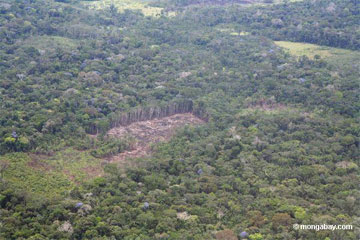FAO deforestation stats are bogus and inaccurate says UK-based group
Rainforest Foundation news release
November 14, 2005
The Rainforest Foundation today claimed that new figures released today by the United Nations on the ‘state of the world’s forests’ are misleading, inaccurate and understate the real extent of deforestation and damage to forests globally. [1]
The new UN figures purport to show that the rate of “net forest loss is slowing down, thanks to new planting and natural expansion of existing forests”. [2]
However, analysis by the Rainforest Foundation indicates that there are major methodological flaws in the UN’s report, especially that:
* the UN figure for ‘net’ deforestation is grossly misleading, as it conceals the fact that most deforestation is taking place in the world’s tropical rainforests, whereas most of the reforestation and natural re-growth of forests is taking place in the northern hemisphere, and much of this consists of plantations rather than forests.
* the UN figure is based on a definition of forest as being an area with as little as 10% actual tree cover, which would therefore include areas that are actually savannah-like ecosystems and badly damaged forests;
* areas of land that presently have no trees on them at all, but that are ‘expected’ to regenerate, are also counted as forests;
 Deforestation in Peru. According to the Rainforest Foundation, FAO might count such landscapes as “forest” |
* the UN includes in its data for existing areas of forest those that are covered by industrial tree plantations, which are actually lacking some of the key functions of true forests;
These flaws are analysed in detail in a new Rainforest Foundation report, entitled ‘Irrational Numbers: Why the FAO’s Forest Assessments are Misleading”, which is published today to coincide with the release of the new UN figures [3].
Simon Counsell, of the Rainforest Foundation, said: “It is a global disgrace that, after decades of concern about the world’s declining forests, the United Nations still can’t even produce an accurate assessment of how much forest is actually left. The new Forest Resources Assessment repeats the bad science of previous assessments, which have been widely criticised, and obscures the real extent of deforestation. The United Nations should scrap this latest report, should make a firm commitment to revising the methods by which it assesses and reports on the state of the world’s forests, and should then set out an urgent plan as to how global deforestation can be halted.”
For further information:
Notes to editors:
[1] The UN Food and Agriculture Organisation – the agency which has lead responsibility for forests within the UN system – today launched its ‘Global Forest Resource Assessment’ for 2005. Similar reports have been produced since 1948.
[2] The press release issued by the FAO today claims that “The annual net loss of forest area between 2000 and 2005 was 7.3 million hectares/year… down from an estimated 8.9 million hectares/year between 1990 and 2000” (FAO)
[3] A copy of ‘Irrational Numbers’ is available for download free from: The Rainforest Foundation
This article is based on a press release from The Rainforest Foundation.